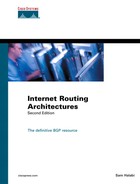Aggregation
Configuring aggregation for single or multiple AFs was complex if varying policies were required. This section provides information on both old and new methods of configuring aggregation.
Old Style
In the old style, a multicast aggregate was configured the same way you configured a unicast aggregate—via the aggregate-address command. The aggregate-address command was enhanced to specify whether the aggregate address should be applied to unicast or multicast using the nlri keyword in the aggregate-address command. The following is an example of generating an aggregate in the multicast BGP table:
router bgp 109 aggregate-address 174.0.0.0 255.0.0.0 as-set nlri multicast
The nlri options that can be specified on an aggregate-address command are unicast, multicast, and unicast multicast, which generate aggregates in the BGP table, in the multicast BGP table, or in both, respectively. The absence of the nlri keyword in the aggregate-address command results in the aggregate's being generated as unicast only.
AF Style
The presence of AF modes for different AFs eliminates the need for the nlri keyword in the aggregate-address command. The AF mode under which the aggregate is specified determines the table where the aggregated prefix should be generated. Hence, the aggregate displayed in the old-style section can be generated in the AF style as follows:
router bgp 109 ! address-family ipv4 multicast aggregate-address 174.0.0.0 255.0.0.0 as-set
